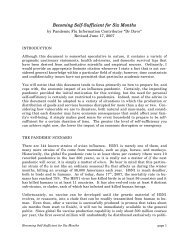You also want an ePaper? Increase the reach of your titles
YUMPU automatically turns print PDFs into web optimized ePapers that Google loves.
WHITE SPORE PRINT<br />
texture, (3) the gills, which are just as tough as the cap and often<br />
interbranched to form pores, and (4) its growth on wood.<br />
This particular species (Figure 27) is exceedingly common on<br />
old birch and aspen logs, growing in rather large clusters, as the<br />
illustration indicates. The caps are i or 2 inches wide and from<br />
1/4 to 1/2 inch thick where they are attached to the wood on<br />
which they grow. The upper side in fresh specimens is woolly and<br />
beautifully zoned in orange, gray, and tan. Though edible, this<br />
species is far too tough and leathery to be relished.<br />
GENUS Lepiota<br />
The genus name, meaning scaly, is descriptive of the surface<br />
of the caps in many species. The genus is characterized by (i)<br />
white spores, (2) free gills, (3) a definite ring around the stem,<br />
and (4) the fact that the stem separates readily from the cap —<br />
such definite characteristics that it is ordinarily one of the easiest<br />
genera for a beginner to recognize. In shape and size as well as<br />
in other features these mushrooms resemble the deadly genus<br />
Amanita, but they differ in that the stem parts from the cap easily<br />
and cleanly when worked this way and that.<br />
Two of the three species here described, Lepiota procera and<br />
Lepiota rachodes, are edible, but L.rachodes resembles Lepiota<br />
morgani so closely that any beginner should avoid it. L. morgani is<br />
poisonous, and mushroom hunters with years of experience have<br />
often mistaken it for Lepiota rachodes, eaten it, and become dangerously<br />
ill. This is another example of the need for extreme<br />
caution in eating mushrooms about whose identity there is the<br />
slightest doubt and of the danger run by people who do not<br />
distinguish between what they believe they know and what they<br />
know they know.<br />
Young plants of Lepiota morgani might also be confused with<br />
Agaricus, especially if the two come up near one another, as they<br />
sometimes do. For this reason, if you pick young mushrooms having<br />
(i) a definite veil or ring, (2) free gills, and (3) white gills, do<br />
not eat them until you have made a spore print of each.<br />
55
















